The framework of this essay is based on analyzing the bilateral relations between Iran and Iraq during the past 50 years. To reach the goal this study utilizes Discourse Theory of Laclau and Mouffe to examine the ruling discourses on the relations between the two countries from the outset of Saddam Hossein's leadership until now and to explain how and why the discourse of Iranophobia is dominated on the Iran-Iraq relations. This study uses descriptive-analytical methods and the inferential methodology has been used to reach these goals. Data has been collected by using library and internet sources as well as news sources on the basis of objective-historical data. The research findings shows that Iraq has been the axis of the discourse of Iranophobia during past 50 years during the first decade of Islamic Republic of Iran Saddam was the headman for Iranophobia in the Middle East and after his fall they were hardline Arab leaders who interpreted usual relations between Iran-Iraq authorities as well as their citizen based on dominance resulting in reappearance of the discourse of Iranophobia. The reasons behind the dominance of this discourse trace back to the prodigious influence of Islamic Revolution in the region and its revisionism nature during first and third decades of Islamic Republic of Iran.
Received: 2014/01/4 | Accepted: 2014/07/11 | Published: 2015/02/17
| Rights and permissions | |
 |
This work is licensed under a Creative Commons Attribution-NonCommercial 4.0 International License. |



